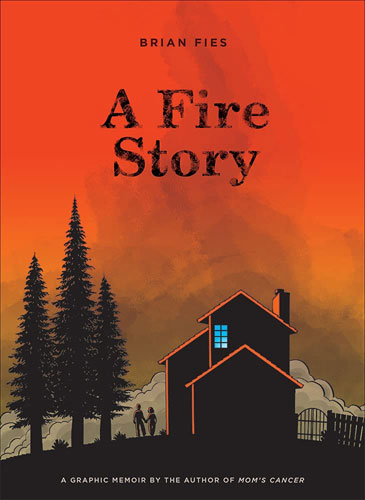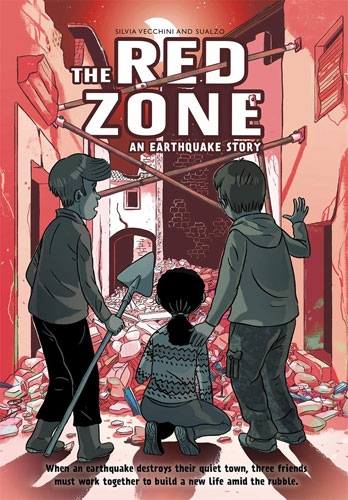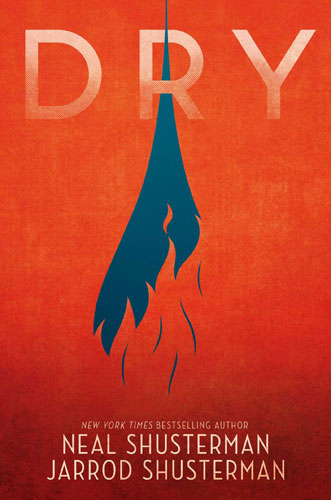Today’s stack is disastrous: these are all tales of catastrophe, some caused by people and some natural—though, of course, we’re constantly learning that human activities are contributing to the frequency and intensity of many natural disasters as well. It’s not that I’m trying to bring you down with these stories, but I feel like we are seeing stories like this in the news, and these books can give us a different perspective on things, particularly in the way some of them can humanize or personalize stories that can feel too big for us to wrap our brains around.
Science Comics: Wild Weather written by MK Reed, illustrated by Jonathan Hill
We’ll start with a book that’s more on the educational side: Wild Weather is a comics-format book that lays out the basics of weather and climate. In case you’re not already familiar with Science Comics, let me preface by just saying they’re awesome. There are a bunch of them now on different topics from trees to flying machines to plagues (another one that’s particularly relevant these days) to the solar system, and my youngest daughter has read the ones we have so often that she uses them as reference books. The other day we were having a conversation about something and she said “Oh, wait!” and pulled one off the shelf to look up a pertinent fact to share with me. Most of the comics, though they’re factual, have some sort of fictional framing story, so you get some narrative and not just a string of facts.
For Wild Weather, the framing story is a TV news station: Stormin’ Norman Weatherby, the meteorologist, gives the forecast for the expected “Snowpocalypse,” and then Chase McCloud, the anchor, makes a crack about global warming. Norman breaks in and says that’s not how global warming actually works—and thus begins the education of the clueless news anchor, who asks a lot of very basic questions so that Norman can explain to him (and the reader) what makes the weather. It includes things like the atmosphere and air pressure and the Coriolis effect, why we have seasons, and what different types of clouds tell us about the weather.
The reason I’ve got this one on the list today is that, as you’d expect, Wild Weather also includes some natural disasters like the aforementioned snowpocalypse, tornadoes and hurricanes, floods, and more. Norman explains how storms are formed, and also walks Chase through the ways in which climate change exacerbates extreme weather. With the recent destruction wrought by Hurricane Ida, this book could help kids understand a bit of the science behind what’s happening.
A Fire Story by Brian Fies
In October 2017, cartoonist Brian Fies lost his home in the Tubbs Fire, which swept through Northern California and destroyed thousands of homes and other buildings. He drew some cartoons about it in the days following and posted them on his website, where they went viral—eventually even being turned into an animated version that was picked up by National Public Radio. This is a full-length comic book, a more polished and heavily expanded version of Fies’ original 18-page comic, and it recounts the experience through a lot of the small details that you might not think of if you haven’t been through it yourself.
The story begins with Fies and his wife waking up in the middle of the night, realizing that something is wrong, and then the hurried evacuation. He describes the geography of that region and the path of the fire, but most of what we get to see is the personal side: the various things they took with them, with the expectation that they’d be back later. We see the neighborhood afterward: entire streets of houses gone, melted and misshapen mailboxes, a barely recognizable landscape. All of that happens in the first few pages, though—and it’s the sort of thing that is familiar to me from the news.
The rest of the book, though, is about what happens afterward. Where do you put thousands of people who have been displaced? Most of them had no houses, but still needed to stay nearby so they could deal with recovery, insurance, rebuilding. Fies recounts little moments called “A Day in the New Life,” things he keeps remembering that he lost in the fire. There are all the frustrations dealing with all of the logistics involved in things like canceling utilities, making insurance claims, and trying to find (or build) a new home.
The book also includes several stories from other people in the region—not all of them lost their homes, but all of them had stories about what happened during the fire: their stories of evacuation, what they took with them and what they left behind. It’s heartbreaking to read, and hard to think that these only scratch the surface of the sheer amount that was claimed by the fire.
A Fire Story isn’t a nice, happy story to read, though there are moments of hope and optimism as well as the loss. I do think it’s an important one, though, because the forest fires are going to keep burning each year, and as we’ve already seen, climate change is affecting them as well.
The Red Zone: An Earthquake Story by Silvia Vecchini and Sualzo
This book, translated from Italian, is a fictional story inspired by some earthquakes that hit central Italy in 2016. It’s focused on a small village that suffered a lot of damage, and the story is told from the perspective of a couple of the kids who lived there, usually following Matteo and his interactions with his friends and family. They’re now living in a tent village (except those who were fortunate enough to find relatives to live with, or had a mobile home, or found a different solution), going to school in a tent, and are forbidden from going into the “red zone,” where there’s still danger of collapsing buildings.
There’s not a big overarching story in the book, but it’s more about the small, connected moments that the kids experience. Matteo’s little sister keeps asking when they’re going home, or expecting things to go back to normal. Federico’s dog was left behind during the earthquake, and he wants to sneak back into the red zone to look for him. Matteo’s parents are divorced, and there are some awkward encounters when he’s spending time with his dad or his stepdad. It’s a lot of little moments that help show what happens after the earthquake aside from the images of destruction that we see, a bit like in A Fire Story. The story shows how life can be disrupted, but also offers a hint of optimism, that things can get better.
Dry by Neal Shusterman and Jarrod Shusterman
The last title on today’s list is the only one that isn’t a comic book. This one is a YA dystopian novel, published a couple years ago, and it’s about a water crisis in southern California. Droughts have been worse, reservoirs have been drying up, and the last straw that kicks off this story is that Nevada has shut off water to California. California’s governor tries to reassure the residents that things are under control, but they finally know how bad things actually are when the taps stop flowing.
The Tap-Out, as it’s called, sets off a crisis, and it’s not hard to see in this story some parallels to things we’ve experienced ourselves in the past couple years. The description of people at Costco rushing to get the last packages of bottled water may seem familiar to those who tried to buy toilet paper back in 2020 when lockdowns first began, and there’s a lot of wariness and mistrust as people don’t know who to trust.
The story is primarily told from the point of view of two teenagers who live next door to each other: Alyssa and Kelton. Alyssa is more of a typical teenager—she’s got a little brother who can be a bit annoying at times, and her parents are just trying to figure out what to do and how to conserve what little water they’ve got. Kelton’s father is a prepper: they have their own off-grid power supply, a water supply, an arsenal, and they’re ready to head to their bunker if things get bad. Kelton has survival skills, and he’s actually kind of glad for the opportunity to help Alyssa because it gives him an excuse to interact with her. Interspersed throughout the book are other snapshots: a mother trying to get a flight to Northern California with her kids; a driver stuck at a standstill on the highway; a reporter following a truck that appears to be transporting a water supply.
I’ve only gotten a little ways into the book so far, but it’s a compelling and scary picture—any disaster that leaves thousands of people in need at the same time creates the nearly impossible task of addressing everyone’s concerns. If a whole region couldn’t get water from their taps, where do you get it from? How do you get people to places where there is water? How bad will things get?
I’m not particularly fond of Kelton, and I’m a bit wary of where this story will take him. Alyssa has seen him as the creepy kid next door, and when we get his point of view, he does seem a bit creepy. He has bought into his dad’s worldview that people are all sheep or wolves—but that his family are the herders, the sheepdogs, the ones who can take charge and guide the sheep when society collapses. He wants to be the hero, but it’s not clear yet if he actually will be.
My Current Stack
I’m still reading AI 2041 and making my way through those stories along with Dry, and I also just started reading William Shakespeare’s Avengers: The Complete Works by Ian Doescher, the same guy who wrote the William Shakespeare’s Star Wars series. It’s a lot of fun, seeing the Marvel universe rewritten in iambic pentameter, and trying to spot the actual Shakespeare references sprinkled throughout the text. (I did spot one Hamilton reference so far as well.)
Disclosure: I received review copies of these books. Affiliate links to Bookshop.org help support independent bookstores and my writing.








